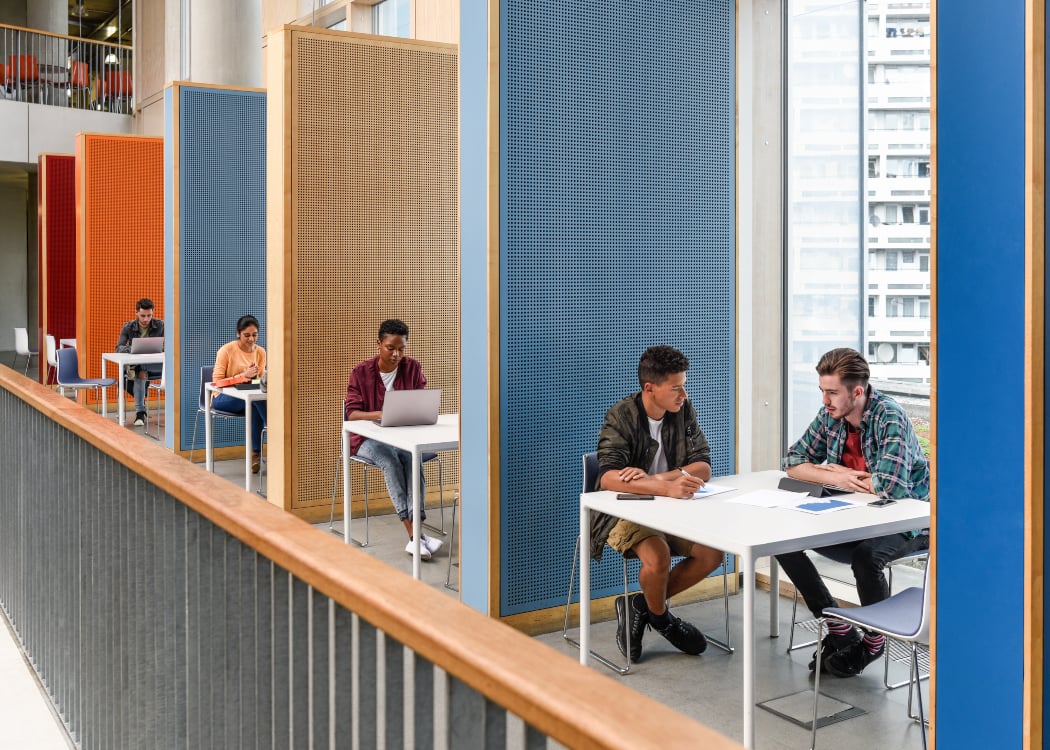
Let us help you with finding an office space
Our experts are here to help take the hard work out of finding your next office space.

One of the key factors in engaging and retaining millennial and generation Z workers is to provide greater flexibility in where, when and how they work. We’ve already discussed hybrid working practices to provide more choice about where and when they work, but what happens when they return to the office full-time? Traditional office layouts don’t provide the flexibility many workers crave, and that’s where an activity-based working office design can come to the fore.
But what is activity-based working, what are the benefits and how can you incorporate it into your office design? Let’s take a look.
Activity-based working is all about giving employees access to areas in the office that are designed specifically to support the nature of the tasks they do. So, rather than having a dedicated workstation where they sit all day and work, they are actively encouraged to move to areas that best suit their style of working and the tasks they do, like in an agile office space.
Introducing activity-based working office design elements into your workspace on its own is not enough to make this workspace approach a success. Workers must also be empowered by the business culture and the technology to choose where, when and how they want to work.
According to Knight Frank research in Australia, activity-based working typically incorporates four key types of working settings:
People are the primary motivation behind the shift to an activity-based approach, and it seems to be working. According to research by the Australian firm, Telsyte, organisations that implement activity-based working are seeing increased productivity, higher engagement and greater collaboration among their employees. Here’s how it can help you.
The Telsyte research found that employees who can engage in activity-based working are 16% more productive than employees working in a traditional way. That’s the equivalent of working 6.4 more hours per week, per employee, based on a 40-hour week.
Activity-based working breaks the traditional, rigid ways of working and gives employees from different departments the freedom to communicate and collaborate. With better communication comes knowledge sharing and new ideas, as well as greater productivity and improved output.

The agile, multi-use of space as promoted by activity-based working can also help to reduce the overall footprint of a business. Activity-based working allows the workforce to be scaled up or down without incurring the cost of acquiring, disposing of or reconfiguring the workspace.
Our survey found that more than half the occupier clients who have implemented activity-based working have maintained or increased their headcount per square foot.
Activity-based working gives employees more autonomy and empowers them to work in a way that suits them. It also tends to be more conducive to hybrid and agile working practices, which is a priority for many millennials and gen Z workers.
Activity-based working also shows your commitment to prioritising the needs of your workers both personally and professionally, which can help to demonstrate your position as a progressive employer and boost employee retention.
To implement an activity-based working office design, the first step — long before you change any spatial elements — is to change your mindset.
The biggest stumbling block can often be getting leaders out of the rigid workplace culture they’ve experienced in the past. You have to think about what your people, regardless of their job title or experience, need to do their jobs in the best possible way. Getting everybody on board with the changes isn’t always easy, but a combination of employee input and pre-project surveys can provide a solid foundation.
Workplace tracking is another solid tactic you can employ to prepare for activity-based working. It will help answer crucial questions, like:
Once you have this information, you can start to think about the specific design elements that will help.
These are comfortable spaces that are designed for activities requiring teamwork and collaboration. Collaborative spaces can be in an enclosed room or an open space with circular seating arrangements. Open lounges are more relaxed, where employees can chat, work individually and collaborate as their work requires.
Workplace designers typically go one of two ways when creating activity-based offices. They either opt for open plant seating plans, which typically give employees several seating options as well as an assigned desk, or free address seating plans. Free address seating plans offer more freedom still, with employees completely untethered to a desk so they can change their workstation on a daily, hourly or task basis.
While activity-based working naturally boosts collaboration, there also needs to be an emphasis on individual workspaces. Private areas, such as individual booths and single-focus rooms, and shared spaces where conversations and phone calls are not allowed, can give workers the space they need to concentrate for deep-focus work.

Café areas are multipurpose spaces that can be a place both to retreat and engage. They should include a range of furniture types, such as tallboy tables for quick meetings and banquette seating options for socialising and working in a more relaxed way.
Meeting spaces are an important part of any activity-based office. They can take the form of breakout spaces for informal meetings and team working or enclosed rooms to provide privacy for client meetings and formal presentations. Project rooms are meeting rooms where no or minimal noise is allowed and are usually for a smaller number of people.
These days, many providers of serviced offices and coworking spaces offer workspaces that include at least some activity-based working office design elements. Different offices will naturally come with different layouts, so it’s important you choose the space that’s best suited to your business needs.
At Knight Frank, we can help you find an activity-based office that works for you. Just tell the team what you’re looking for and we’ll find the flexible office space that meets your requirements. We’ll get you booked in, accompany you to viewings and use our market knowledge to help you negotiate the best lease.
Get your monthly dose of workplace insights, productivity hacks and business leadership ideas - delivered straight to your inbox.

Our experts are here to help take the hard work out of finding your next office space.